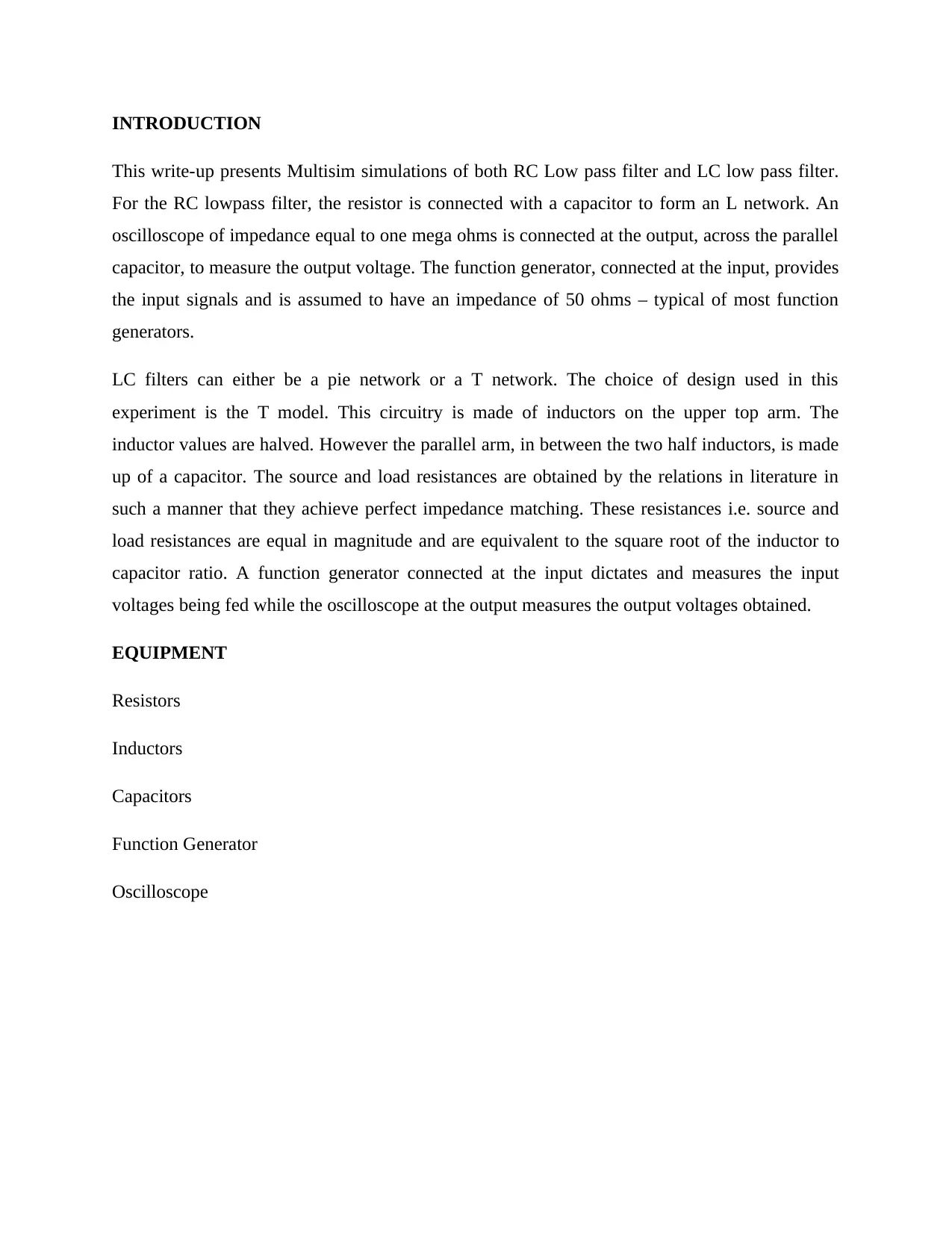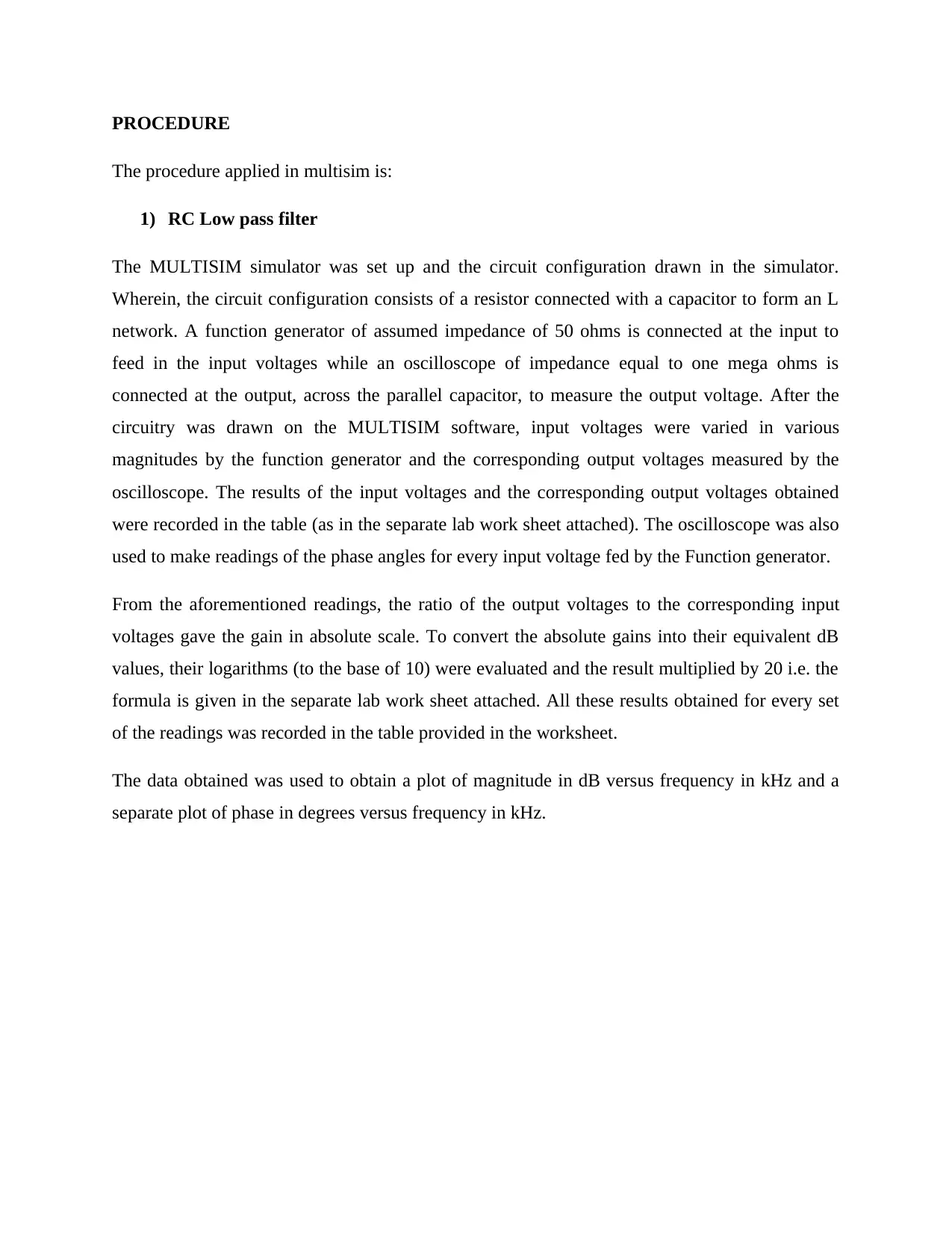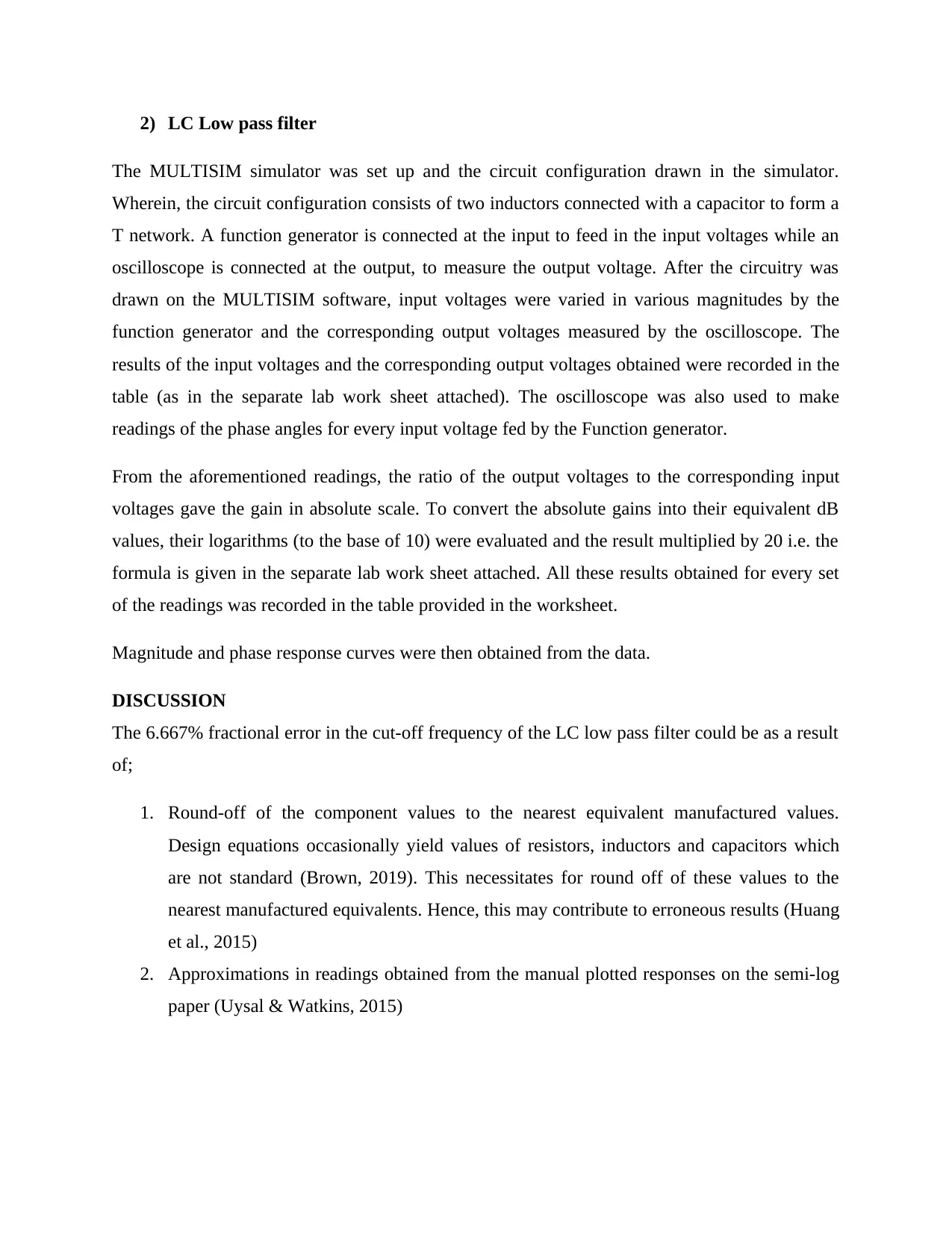ENG530 Analogue Analysis and Design: Filter Design Lab Report
VerifiedAdded on 2022/07/29
|5
|1215
|38
Practical Assignment
AI Summary
This lab report presents the design, simulation, and analysis of both RC and LC low-pass filters using Multisim. The report details the procedures followed, including circuit setup, input voltage variation, and output voltage measurements using an oscilloscope and function generator. It includes the recording of results, gain calculations, and phase angle readings. The data obtained is used to plot magnitude and phase responses. The report also discusses the fractional error in the cut-off frequency of the LC filter and concludes by comparing the characteristics of both filter types, including the order of the filters, the components involved, and the phase shift at the cut-off frequency. The assignment adheres to the requirements of the Analogue Analysis and Design (ENG530) module, focusing on two-port network representation and practical problem-solving in analogue electronics. The assignment is accompanied by a lab worksheet containing additional data.

INTRODUCTION
This write-up presents Multisim simulations of both RC Low pass filter and LC low pass filter.
For the RC lowpass filter, the resistor is connected with a capacitor to form an L network. An
oscilloscope of impedance equal to one mega ohms is connected at the output, across the parallel
capacitor, to measure the output voltage. The function generator, connected at the input, provides
the input signals and is assumed to have an impedance of 50 ohms – typical of most function
generators.
LC filters can either be a pie network or a T network. The choice of design used in this
experiment is the T model. This circuitry is made of inductors on the upper top arm. The
inductor values are halved. However the parallel arm, in between the two half inductors, is made
up of a capacitor. The source and load resistances are obtained by the relations in literature in
such a manner that they achieve perfect impedance matching. These resistances i.e. source and
load resistances are equal in magnitude and are equivalent to the square root of the inductor to
capacitor ratio. A function generator connected at the input dictates and measures the input
voltages being fed while the oscilloscope at the output measures the output voltages obtained.
EQUIPMENT
Resistors
Inductors
Capacitors
Function Generator
Oscilloscope
This write-up presents Multisim simulations of both RC Low pass filter and LC low pass filter.
For the RC lowpass filter, the resistor is connected with a capacitor to form an L network. An
oscilloscope of impedance equal to one mega ohms is connected at the output, across the parallel
capacitor, to measure the output voltage. The function generator, connected at the input, provides
the input signals and is assumed to have an impedance of 50 ohms – typical of most function
generators.
LC filters can either be a pie network or a T network. The choice of design used in this
experiment is the T model. This circuitry is made of inductors on the upper top arm. The
inductor values are halved. However the parallel arm, in between the two half inductors, is made
up of a capacitor. The source and load resistances are obtained by the relations in literature in
such a manner that they achieve perfect impedance matching. These resistances i.e. source and
load resistances are equal in magnitude and are equivalent to the square root of the inductor to
capacitor ratio. A function generator connected at the input dictates and measures the input
voltages being fed while the oscilloscope at the output measures the output voltages obtained.
EQUIPMENT
Resistors
Inductors
Capacitors
Function Generator
Oscilloscope
Paraphrase This Document
Need a fresh take? Get an instant paraphrase of this document with our AI Paraphraser

PROCEDURE
The procedure applied in multisim is:
1) RC Low pass filter
The MULTISIM simulator was set up and the circuit configuration drawn in the simulator.
Wherein, the circuit configuration consists of a resistor connected with a capacitor to form an L
network. A function generator of assumed impedance of 50 ohms is connected at the input to
feed in the input voltages while an oscilloscope of impedance equal to one mega ohms is
connected at the output, across the parallel capacitor, to measure the output voltage. After the
circuitry was drawn on the MULTISIM software, input voltages were varied in various
magnitudes by the function generator and the corresponding output voltages measured by the
oscilloscope. The results of the input voltages and the corresponding output voltages obtained
were recorded in the table (as in the separate lab work sheet attached). The oscilloscope was also
used to make readings of the phase angles for every input voltage fed by the Function generator.
From the aforementioned readings, the ratio of the output voltages to the corresponding input
voltages gave the gain in absolute scale. To convert the absolute gains into their equivalent dB
values, their logarithms (to the base of 10) were evaluated and the result multiplied by 20 i.e. the
formula is given in the separate lab work sheet attached. All these results obtained for every set
of the readings was recorded in the table provided in the worksheet.
The data obtained was used to obtain a plot of magnitude in dB versus frequency in kHz and a
separate plot of phase in degrees versus frequency in kHz.
The procedure applied in multisim is:
1) RC Low pass filter
The MULTISIM simulator was set up and the circuit configuration drawn in the simulator.
Wherein, the circuit configuration consists of a resistor connected with a capacitor to form an L
network. A function generator of assumed impedance of 50 ohms is connected at the input to
feed in the input voltages while an oscilloscope of impedance equal to one mega ohms is
connected at the output, across the parallel capacitor, to measure the output voltage. After the
circuitry was drawn on the MULTISIM software, input voltages were varied in various
magnitudes by the function generator and the corresponding output voltages measured by the
oscilloscope. The results of the input voltages and the corresponding output voltages obtained
were recorded in the table (as in the separate lab work sheet attached). The oscilloscope was also
used to make readings of the phase angles for every input voltage fed by the Function generator.
From the aforementioned readings, the ratio of the output voltages to the corresponding input
voltages gave the gain in absolute scale. To convert the absolute gains into their equivalent dB
values, their logarithms (to the base of 10) were evaluated and the result multiplied by 20 i.e. the
formula is given in the separate lab work sheet attached. All these results obtained for every set
of the readings was recorded in the table provided in the worksheet.
The data obtained was used to obtain a plot of magnitude in dB versus frequency in kHz and a
separate plot of phase in degrees versus frequency in kHz.

2) LC Low pass filter
The MULTISIM simulator was set up and the circuit configuration drawn in the simulator.
Wherein, the circuit configuration consists of two inductors connected with a capacitor to form a
T network. A function generator is connected at the input to feed in the input voltages while an
oscilloscope is connected at the output, to measure the output voltage. After the circuitry was
drawn on the MULTISIM software, input voltages were varied in various magnitudes by the
function generator and the corresponding output voltages measured by the oscilloscope. The
results of the input voltages and the corresponding output voltages obtained were recorded in the
table (as in the separate lab work sheet attached). The oscilloscope was also used to make
readings of the phase angles for every input voltage fed by the Function generator.
From the aforementioned readings, the ratio of the output voltages to the corresponding input
voltages gave the gain in absolute scale. To convert the absolute gains into their equivalent dB
values, their logarithms (to the base of 10) were evaluated and the result multiplied by 20 i.e. the
formula is given in the separate lab work sheet attached. All these results obtained for every set
of the readings was recorded in the table provided in the worksheet.
Magnitude and phase response curves were then obtained from the data.
DISCUSSION
The 6.667% fractional error in the cut-off frequency of the LC low pass filter could be as a result
of;
1. Round-off of the component values to the nearest equivalent manufactured values.
Design equations occasionally yield values of resistors, inductors and capacitors which
are not standard (Brown, 2019). This necessitates for round off of these values to the
nearest manufactured equivalents. Hence, this may contribute to erroneous results (Huang
et al., 2015)
2. Approximations in readings obtained from the manual plotted responses on the semi-log
paper (Uysal & Watkins, 2015)
The MULTISIM simulator was set up and the circuit configuration drawn in the simulator.
Wherein, the circuit configuration consists of two inductors connected with a capacitor to form a
T network. A function generator is connected at the input to feed in the input voltages while an
oscilloscope is connected at the output, to measure the output voltage. After the circuitry was
drawn on the MULTISIM software, input voltages were varied in various magnitudes by the
function generator and the corresponding output voltages measured by the oscilloscope. The
results of the input voltages and the corresponding output voltages obtained were recorded in the
table (as in the separate lab work sheet attached). The oscilloscope was also used to make
readings of the phase angles for every input voltage fed by the Function generator.
From the aforementioned readings, the ratio of the output voltages to the corresponding input
voltages gave the gain in absolute scale. To convert the absolute gains into their equivalent dB
values, their logarithms (to the base of 10) were evaluated and the result multiplied by 20 i.e. the
formula is given in the separate lab work sheet attached. All these results obtained for every set
of the readings was recorded in the table provided in the worksheet.
Magnitude and phase response curves were then obtained from the data.
DISCUSSION
The 6.667% fractional error in the cut-off frequency of the LC low pass filter could be as a result
of;
1. Round-off of the component values to the nearest equivalent manufactured values.
Design equations occasionally yield values of resistors, inductors and capacitors which
are not standard (Brown, 2019). This necessitates for round off of these values to the
nearest manufactured equivalents. Hence, this may contribute to erroneous results (Huang
et al., 2015)
2. Approximations in readings obtained from the manual plotted responses on the semi-log
paper (Uysal & Watkins, 2015)
⊘ This is a preview!⊘
Do you want full access?
Subscribe today to unlock all pages.

Trusted by 1+ million students worldwide

CONCLUSION
In conclusion, it is observed that the highest power of s in the denominators of transfer functions
derived for the RC low pass filter is one thus it is a first order low pass filter. Its first order
nature is because the circuitry consists of only two passive elements i.e. a capacitor and resistors.
The oscilloscope provides load resistance (RL) while the function generator offers resistance (Rs).
Combined effects of all these two resistances with the resistor making up the filter unit make up
the overall resistance of the circuit.
However, for LC low pass filter, the highest power of s in the characteristic equation is three
making it a three pole system or a third order system. This is because the circuitry is made up
of all the three passive components i.e. there exists a capacitor, an inductor and resistors. The
resistors are modeled from the function generator and oscilloscope and they are used for
impedance matching (Nassir, 2017)
The LC low pass filter gives a phase of -135o at the cut off frequency because of the inductor
involved while that of the RC low pass filter is -45o because only a capacitor is involved.
In conclusion, it is observed that the highest power of s in the denominators of transfer functions
derived for the RC low pass filter is one thus it is a first order low pass filter. Its first order
nature is because the circuitry consists of only two passive elements i.e. a capacitor and resistors.
The oscilloscope provides load resistance (RL) while the function generator offers resistance (Rs).
Combined effects of all these two resistances with the resistor making up the filter unit make up
the overall resistance of the circuit.
However, for LC low pass filter, the highest power of s in the characteristic equation is three
making it a three pole system or a third order system. This is because the circuitry is made up
of all the three passive components i.e. there exists a capacitor, an inductor and resistors. The
resistors are modeled from the function generator and oscilloscope and they are used for
impedance matching (Nassir, 2017)
The LC low pass filter gives a phase of -135o at the cut off frequency because of the inductor
involved while that of the RC low pass filter is -45o because only a capacitor is involved.
Paraphrase This Document
Need a fresh take? Get an instant paraphrase of this document with our AI Paraphraser

References
Brown, J. M. (2019). Chapter 2: Classical results of network synthesis. Passive Network
Synthesis: An Approach to Classification, 5-18.
Huang, C., Chen, C., Zhou, M. J., & Wu, J. H. (2015). An active-RC reconfigurable lowpass-
polyphase biquad filter for wireless receiver. Analog Integrated Circuits and Signal
Processing, 84(1), 97-105.
Nassir, H. S. (2017). Basic analysis of resistive circuits. Electric Circuits and Signals, 83-112.
Uysal, S., & Watkins, J. (2015). Novel microstrip low-pass/high-pass directional couplers/filters.
IEEE Proceedings on Southeastcon.
Brown, J. M. (2019). Chapter 2: Classical results of network synthesis. Passive Network
Synthesis: An Approach to Classification, 5-18.
Huang, C., Chen, C., Zhou, M. J., & Wu, J. H. (2015). An active-RC reconfigurable lowpass-
polyphase biquad filter for wireless receiver. Analog Integrated Circuits and Signal
Processing, 84(1), 97-105.
Nassir, H. S. (2017). Basic analysis of resistive circuits. Electric Circuits and Signals, 83-112.
Uysal, S., & Watkins, J. (2015). Novel microstrip low-pass/high-pass directional couplers/filters.
IEEE Proceedings on Southeastcon.
1 out of 5
Related Documents
Your All-in-One AI-Powered Toolkit for Academic Success.
+13062052269
info@desklib.com
Available 24*7 on WhatsApp / Email
![[object Object]](/_next/static/media/star-bottom.7253800d.svg)
Unlock your academic potential
Copyright © 2020–2025 A2Z Services. All Rights Reserved. Developed and managed by ZUCOL.





